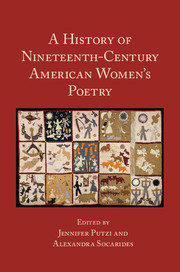Book contents
- Frontmatter
- Contents
- List of Illustrations
- List of Contributors
- Acknowledgments
- Introduction: Making History: Thinking about Nineteenth-Century American Women's Poetry
- PART I 1800–1840, AMERICAN POESIS AND THE NATIONAL IMAGINARY
- 1 Claiming Lucy Terry Prince: Literary History and the Problem of Early African American Women Poets
- 2 Before the Poetess: Women's Poetry in the Early Republic
- 3 The Passion for Poetry in Lydia Sigourney and Elizabeth Oakes Smith
- 4 Album Verse and the Poetics of Scribal Circulation
- 5 Presents of Mind: Lydia Sigourney, Gift Book Culture, and the Commodification of Poetry
- 6 The Friendship Elegy
- 7 Gendered Atlantic: Lydia Sigourney and Felicia Hemans
- PART II 1840–1865, UNIONS AND DISUNIONS
- PART III 1865–1900, EXPERIMENT AND EXPANSION
- Suggested Further Reading
- Index
2 - Before the Poetess: Women's Poetry in the Early Republic
from PART I - 1800–1840, AMERICAN POESIS AND THE NATIONAL IMAGINARY
Published online by Cambridge University Press: 21 January 2017
- Frontmatter
- Contents
- List of Illustrations
- List of Contributors
- Acknowledgments
- Introduction: Making History: Thinking about Nineteenth-Century American Women's Poetry
- PART I 1800–1840, AMERICAN POESIS AND THE NATIONAL IMAGINARY
- 1 Claiming Lucy Terry Prince: Literary History and the Problem of Early African American Women Poets
- 2 Before the Poetess: Women's Poetry in the Early Republic
- 3 The Passion for Poetry in Lydia Sigourney and Elizabeth Oakes Smith
- 4 Album Verse and the Poetics of Scribal Circulation
- 5 Presents of Mind: Lydia Sigourney, Gift Book Culture, and the Commodification of Poetry
- 6 The Friendship Elegy
- 7 Gendered Atlantic: Lydia Sigourney and Felicia Hemans
- PART II 1840–1865, UNIONS AND DISUNIONS
- PART III 1865–1900, EXPERIMENT AND EXPANSION
- Suggested Further Reading
- Index
Summary
In January of 1790, The Massachusetts Magazine; or, Monthly Museum faced an embarrassing excess of Constantias. The magazine had been publishing poetry by Sarah Wentworth Morton under the name Constantia throughout its first year, but now the editors were adding Judith Sargent Murray to their list of essayists and poets and she asserted a prior claim to the pseudonym. The following notice appeared under the heading “To the FAVOURITES of the MUSES,” immediately following the table of contents:
The adoption of a signature already used by a justly admired writer, was rather delicately embarrassing to the Editors; they flatter themselves that their late, and early friend, will both feel themselves pleased at their attention to prevent mistakes. The authoress of Invocation to Hope; Philander, a pastoral Elegy; Lines to Euphelia, &c. will in future have her name decorated with a Star (*) at the end of it, unless one or other of the fair competitors in poetical fame, should be pleased to alter her signature, when due notice will be given, as we sincerely wish to be in the good graces of these valuable writers.
Changing the pen name of Morton, a well-regarded poet who was socially prominent in Boston, was awkward enough; that she was understood by many readers to be using her poetry to mourn the suicide of her sister who had given birth to a child conceived with Morton's husband, Perez, may have made the editors and other contributors even more sensitive to her feelings. As Morton cycled through Constantia*, Philenia Constantia, and finally Philenia during the first half of 1790, the magazine published numerous encomia to her by the editors and other contributors, including Murray. Both the confusion over names and the effusive praise is evident in April, for instance, when Euphelia, a contributor who often framed her poems as responses to Morton's, addressed a poem “To CONSTANTIA*” while Murray, on the same page and using the name Constantia herself, contributed “LINES to PHILENIA.” The editors’ delicacy did not, however, keep them from pitting the two Constantias against each other as “fair competitors in poetical fame,” and extravagant praise of both women kept alive the idea that one could be best.
- Type
- Chapter
- Information
- A History of Nineteenth-Century American Women's Poetry , pp. 37 - 52Publisher: Cambridge University PressPrint publication year: 2016

